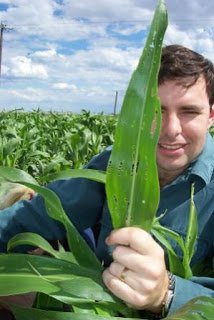Corn earworm larvae on vegetative sorghum crops produce characteristic holes in the leaves after feeding in the throat of the plant. These tell-tale signs are of no great concern as this type of feeding will not affect crop yield.
The recent presence of high numbers of corn earworm, Helicoverpa armigera, on winter cereals and chickpea could herald the beginning of a busy time ahead for grain sorghum in southern Queensland.
As larvae on cereal crops mature, they climb down the plant and burrow into the soil to pupate. Moths emerge from these pupae 2 to 3 weeks later, and start the next generation by laying eggs on suitable host plants.
Vegetative sorghum is attractive to egglaying moths, and larvae hatch from newly laid eggs in 3 to 4 days. Survival of larvae on vegetative crops may not be high, but vegetative sorghum can be an important intermediate host that bridges the gap between winter and summer.
Armyworm larvae may also be present in vegetative sorghum. Armyworm larvae cause sorghum plants to look ‘ragged’, but again this leaf feeding does not result in any yield loss in advanced and actively growing seedling crops.
Control of larvae on vegetative sorghum is generally not recommended as the damage is cosmetic and unlikely to affect yield.
While corn earworm larvae are advertising their presence in southern Queensland grain sorghum crops, of greatest importance are larval infestations after flowering and during grain fill.
Egglaying by corn earworm moths and larval management on sorghum heads will be the subject of a future posting.

